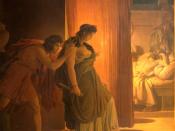To the Greeks, imagination is the most useful tool in telling a story. In today's world, everything must be plastered on the screen or on stage, but in any Greek play the audience will notice that none of the violent acts are performed, but are hidden behind closed doors. By taking a look at The Orestes Plays of Aeschylus, Sophocles's Oedipus Rex and Antigone, and Euripides's Medea, the truth reveals that a messenger, the chorus, or the murderer tells the tale of violence in every play. The Greeks reveal nothing to the naked eye, but leave the curious mind to interpret the violent acts.
In two of the three plays that make up The Orestes Plays of Aeschylus, revengeful death is the axis point, but not one act of murder is shown on stage. In the tragic tale, The Agamemnon, Clytemnestra kills Orestes' father, Agamemnon. The scene is set with the chorus outside the room where Clytemnestra and Agamemnon meet.
The sound of "[Agamemnon's death groan is heard from inside the parlor]" and then again Agamemnon gives out a shout declaring, "O-oh! I am hitâ¦mortally hitâ¦within." It is the chorus that finally tells the audience of Agamemnon's death by saying, "The deed is done. You heard the king cry outâ¦" The audience does not see this act of murder, but hears the noises that come from behind the closed doors.
In continuation with the trilogy, the second play, The Libation Bearers, has not one, but two deaths. In each one of the deaths, the servant or Orestes play a huge role in informing the audience of unseen events. Orestes arrives at the palace in disguise and is out for the vengeance of his father's death. Once again the familiar phrase, "[Aegisthus's death-cry is heard...


